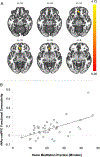Meditation Practice, Mindfulness, and Pain-Related Outcomes in Mindfulness-Based Treatment for Episodic Migraine
- PMID: 38435377
- PMCID: PMC10907069
- DOI: 10.1007/s12671-023-02105-8
Meditation Practice, Mindfulness, and Pain-Related Outcomes in Mindfulness-Based Treatment for Episodic Migraine
Abstract
Objectives: Mindfulness-based interventions (MBIs) have emerged as promising prophylactic episodic migraine treatments. The present study investigated biopsychosocial predictors and outcomes associated with formal, daily-life meditation practice in migraine patients undergoing MBI, and whether augmented mindfulness mechanistically underlies change.
Methods: Secondary analyses of clinical trial data comparing a 12-week enhanced mindfulness-based stress reduction course (MBSR + ; n = 50) to stress management for headache (SMH; n = 48) were conducted.
Results: Pre-treatment mesocorticolimbic system functioning (i.e., greater resting state ventromedial prefrontal cortex-right nucleus accumbens [vmPFC-rNAC] functional connectivity) predicted greater meditation practice duration over MBSR + (r = 0.58, p = 0.001), as well as the change in headache frequency from pre- to post-treatment (B = -12.60, p = 0.02) such that MBSR + participants with greater vmPFC-rNAC connectivity showed greater reductions in headache frequency. MBSR + participants who meditated more showed greater increases in mindfulness (B = 0.52, p = 0.02) and reductions in the helplessness facet of pain catastrophizing (B = -0.13, p = 0.01), but not headache frequency, severity, or impact. Augmented mindfulness mediated reductions in headache impact resulting from MBSR + , but not headache frequency.
Conclusions: Mesocorticolimbic system function is implicated in motivated behavior, and thus, motivation-enhancing interventions might be delivered alongside mindfulness-based training to enhance meditation practice engagement. Formal, daily-life meditation practice duration appears to benefit pain-related cognitions, but not clinical pain, while mindfulness emerges as a mechanism of MBIs on headache impact, but not frequency. Further research is needed to investigate the day-to-day effects of formal, daily-life meditation practice on pain, and continue to characterize the specific mechanisms of MBIs on headache outcomes.
Preregistration: This study is not preregistered.
Keywords: Headache; Home practice; Meditation practice; Mindfulness; Motivation.
Conflict of interest statement
Conflict of Interest The authors declare no competing interests.
Figures





Similar articles
-
Meditation for migraines: a pilot randomized controlled trial.Headache. 2014 Oct;54(9):1484-95. doi: 10.1111/head.12420. Epub 2014 Jul 18. Headache. 2014. PMID: 25041058 Clinical Trial.
-
Effectiveness of Mindfulness Meditation vs Headache Education for Adults With Migraine: A Randomized Clinical Trial.JAMA Intern Med. 2021 Mar 1;181(3):317-328. doi: 10.1001/jamainternmed.2020.7090. JAMA Intern Med. 2021. PMID: 33315046 Free PMC article. Clinical Trial.
-
Enhanced mindfulness-based stress reduction in episodic migraine: a randomized clinical trial with magnetic resonance imaging outcomes.Pain. 2020 Aug;161(8):1837-1846. doi: 10.1097/j.pain.0000000000001860. Epub 2020 Mar 13. Pain. 2020. PMID: 32701843 Free PMC article. Clinical Trial.
-
Mindfulness and bodily distress.Dan Med J. 2012 Nov;59(11):B4547. Dan Med J. 2012. PMID: 23171754 Review.
-
Do workplace-based mindfulness meditation programs improve physiological indices of stress? A systematic review and meta-analysis.J Psychosom Res. 2018 Nov;114:62-71. doi: 10.1016/j.jpsychores.2018.09.010. Epub 2018 Sep 22. J Psychosom Res. 2018. PMID: 30314581
Cited by
-
fMRI-based explanations for how meditation could modulate pain processing.Front Neurosci. 2025 May 16;19:1561580. doi: 10.3389/fnins.2025.1561580. eCollection 2025. Front Neurosci. 2025. PMID: 40454249 Free PMC article.
References
Grants and funding
LinkOut - more resources
Full Text Sources
